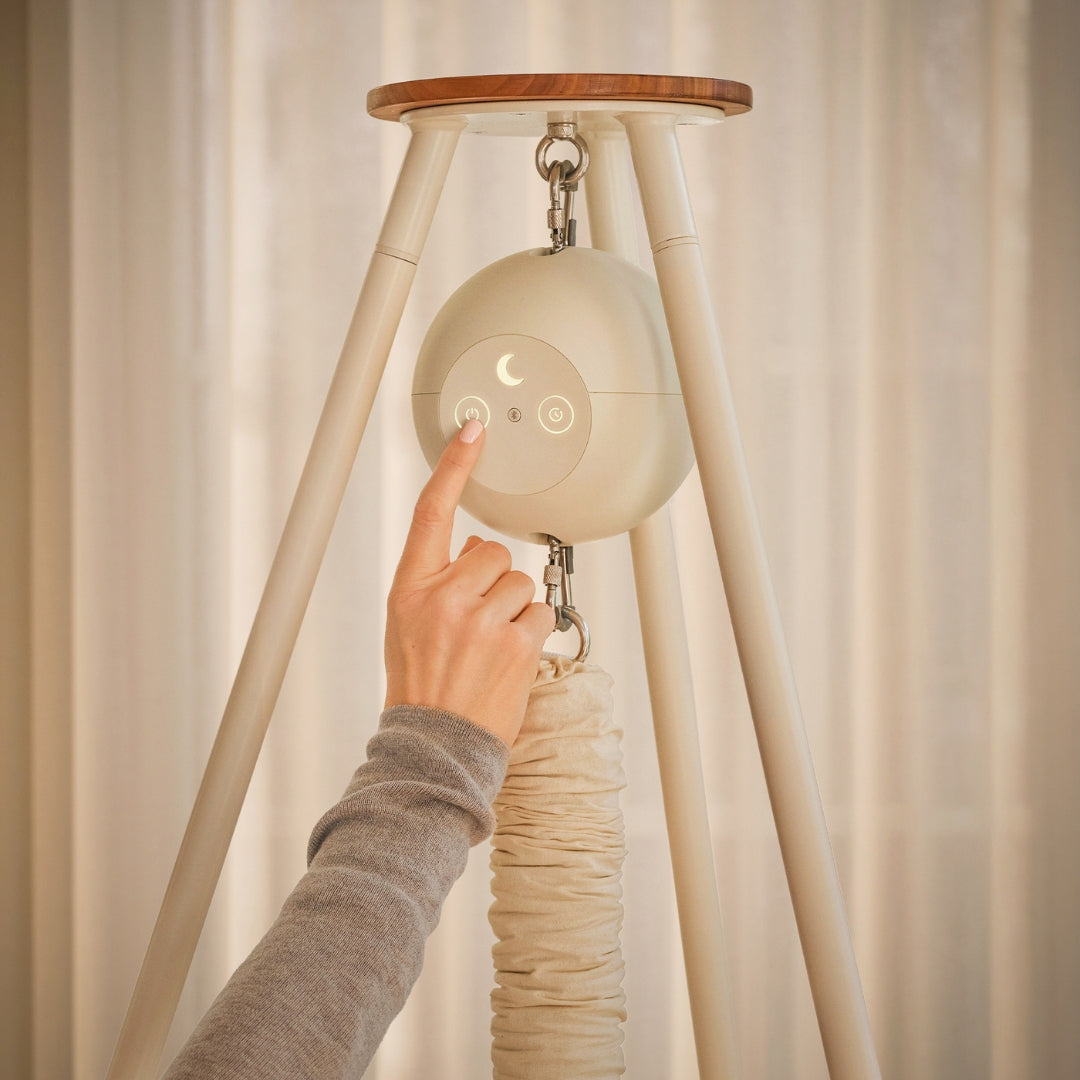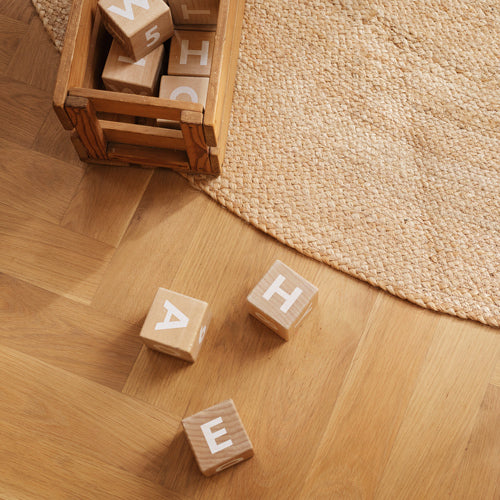


What is reflux and colic?– and why is the baby hammock a good option for children dealing with these issues?
They are constantly crying. You desperately try to ease the crying, but it feels as if nothing really helps. It is incredibly hard to have a baby suffering from reflux or colic. As a parent, it can be difficult to cope with the long-term discomfort and the many different pieces of advice and views on how to handle the situation.
In this article, we will take a quick look at what colic and reflux really entail, and explain why the baby hammock is often a good option for children experiencing these issues.
NB: The baby hammock is an aid that can help both a baby and its parents through a time when the child is experiencing discomfort and crying frequently. The baby hammock can help the child find peace and fall asleep and can relieve the parents and give them a little break when they need it the most. The baby hammock however, cannot "fix" reflux or colic – only time, possibly, treatment/relief of the child's symptoms, and, in some cases, treatment of the child's underlying problems causing the reflux or colic symptoms, can do that. This is why we always recommend that you contact your own doctor or health visitor for advice and diagnosis of your exact situation.
What are colic and reflux?
There are many different descriptions of both colic and reflux. Some descriptions are based on research and common knowledge – others are less knowledge-based and are based on people's own experiences and views.
How can parents navigate the information overload?
Doctor Elise Stjernholm will try to guide us through this topic, together with sleep and breastfeeding counsellor, Mia Bernscherer Bjørnfort from Sovende Børn.

Colic
Let's start by taking a closer look at colic, which is neither a disease, nor an actual diagnosis. In order words, a baby cannot "have colic", as it is really a term covering situations when the child cries frequently and you do not know what is causing the crying.
The patient handbook, Sundhed.dk, defines colic as follows:
“Infantile colic is prolonged screaming or restlessness for more than 3 hours daily, more than 3 days a week in an otherwise healthy child under 5 months, who also has normal weight gain.”
The child keeps crying, seems inconsolable and may also have challenges eating well during crying spells, as the child's whole body is upset and uncomfortable. The child may be helped to calm down or fall asleep, but often only by means of continued assistance in the form of body contact, rocking movements, wrapping in a duvet or blanket, singing, music or white noise from a cooking hood, a washing machine, or other similar devices.
There may indeed be underlying, undiagnosed causes of colic. If you have the slightest doubt, you should always contact your own doctor or health visitor and review the family's situation with them in order to get a holistic assessment of the issue at hand.
Underlying issues with colic
Children may be experiencing a locked hip, pelvis, neck area or the like after birth. They may also have breastfeeding/bottle issues, react to food proteins, have sensory imbalances or other issues that cause excessive crying. Professionals can help the family determine if "something is wrong" before turning to the topic of colic.
It is not uncommon for "colicky children" to subsequently turn out to have had underlying issues, which could possibly have been remedied or mitigated during the child's first months of life.
Treatment for colic
Given that colic is not an actual disease/diagnosis, but a term used to describe "a child who cries frequently for no identifiable reason", there is no professional term covering the treatment of colic in children. Instead, one can attempt to identify any unknown, underlying issues and try to address them to alleviate the discomfort that the child is experiencing, which leads to crying. Treatments for underlying issues may include, for example, osteopathy, sensory-motor courses of treatment offered by an occupational therapist or a lactation consultant.
Treatments that alleviate the child's symptoms/discomfort/crying are more likely to be effective because they (perhaps) have remedied the yet-to-be diagnosed underlying issue or have given the child relief from the discomfort they are experiencing.
Reflux
Reflux can be categorised as "common" reflux (GER) and reflux disease (GERD). However, there is a big difference between the two types of reflux.
Common reflux – or plain "vomit"
Common reflux is often referred to as "regurgitating babies" or "happy regurgitators". This often causes a laundry pileup because of the frequent reflux of the baby's stomach content. Parents find that their child regurgitates – either in smaller, explosive amounts or in much less dramatic ways where the milk simply runs out of the corner of the child's mouth.
Common reflux – vomit – typically causes short-term discomfort in the child during or right before regurgitation. However, the child is easily consoled and may not even require regular consolation.
However, it can still be frustrating to clean up vomit everywhere and not least the resulting dirty laundry, and it can be troublesome to figure out how to minimise the throwing up.
Simple tips on how to cope with regurgitating babies
- More frequent, shorter breastfeeding, instead of "buying time" between each breastfeeding, so the baby eats less at a time
- More frequent, smaller bottle-fed meals, using customised bottle-feeding
- Hold the baby's head up high immediately after a meal
- Allow a little time to pass after a meal before engaging in activities involving the baby's abdominal muscles as these muscles "squeeze" the baby's stomach.
In the midst of the laundry nightmare, it can be a tremendous help to keep in mind that this situation will not last forever. As the baby spends more time in an upright position and will start eating solid food at approximately 6 months of age, the regurgitation will gradually subside.
Reflux disease – much more than just vomit
Reflux disease is a regular disease, which, due to the frequency and/or intensity of reflux, causes considerable discomfort to the child. This may both result in visible reflux or "silent reflux", where the child swallows the vomit while lying down and then flushes it back up.
A child with reflux disease may have obvious symptoms in the form of excessive crying, general agitation and malaise, difficulty latching on to a breast or a bottle and experience discomfort and pain when lying down. It may also have less obvious symptoms, such as reflux several times an hour during sleep, when the baby is awakened by milk and stomach acid that enter the oesophagus and the mouth – or by reflux-related pain.
When the child has visible reflux – vomit, if you will – it can be relatively easy to link the many cases of reflux with the child's overall symptoms of obvious discomfort.
However, it can also be much more difficult to detect that the child is suffering from excessive reflux, especially if the amount of reflux is not great enough to seep out of the mouth making it invisible to the child's parents.
Children with common reflux issues may suffer from the same symptoms as children with visible reflux disease, but it often takes longer to understand that they are due to reflux disease. The symptoms of malaise, arching of the body and eating issues, etc., will in some cases also be assessed as being normal infant behavior or perhaps a sign of colic.
Parents may have noticed that their child seems to swallow repeatedly when lying down – perhaps so much that the child is awakened from their sleep. However, this is not always enough of a reason for health care professionals or the parents themselves to diagnose reflux disease, as young children tend to wake up frequently anyway.
Causes of reflux disease
Sometimes an examination of the child will show an underlying problem as the cause of the reflux symptoms.
Allergy or intolerance to food proteins, especially cow's milk proteins, are a possible cause of reflux disease – close to 40% of children suffering from reflux have a food allergy.
If the parents do not have any allergies, they may find that this possible diagnosis is rejected in advance. However, identifying parents' diagnosed and/or undiagnosed allergies is not a criterion for identifying their child's possible allergies.
Identifying the disease is risk-free and a relatively easy way to rule out or confirm whether it is actually allergies or intolerances that are to blame.
With such a high incidence of allergy-caused reflux disease, it would make sense to try to eliminate, for example, milk proteins in the baby's milk in consultation with the baby's doctor or health visitor.
For this reason, it is important that diagnosing the underlying cause be the first priority in case of suspicions of reflux disease, since treatment of a possible underlying cause of reflux disease, for obvious reasons, is of utmost importance.
In some cases, however, it might not be possible to find the cause of a child’s repeated painful bouts of reflux symptoms. In these cases, it immediately becomes a more complicated situation since at present there are no well-documented forms of treatment available for reflux disease. However, in case of reflux without a known underlying cause, some families experience a positive treatment effect with medication.
If medication is not an option or has not shown any effect, there are other options available to relieve the child's symptoms. For example, by using a baby hammock, by keeping the baby in an upright position, offering plenty of pain-relieving, skin-to-skin contact, and, generally ensuring plenty of good body contact. In this event, unfortunately, only patience will do, including taking "conservative measures" and hoping that time will heal all wounds–which is obviously easier said than done.
Conservative measures are a good way of asking oneself, ‘What can I do myself?’
When you are dealing with a reflux-stricken baby, it is incredibly important to have the support of your family and friends. It is no secret that reflux-stricken children are really sick, even if some people might not be able to understand that it isn't "just normal vomit".
Whether your friends show you support in the form of a kind text message or a family member offers to clean your house or rock your baby for an hour, so you can take a quick break, it all counts.
Many conservative measures target the parents more than the child – precisely because the parents need support, so they, in turn, can support their child.
So, what can you do as a family or a network of people?
- All tips used for common reflux can also be applied to reflux disease.
-
Lots and lots of help from family, friends and co-workers:
- Is anyone able to offer you assistance with errands and other practical stuff?
- Is anyone available to stop by just to hold your baby for a while? For example, skin-to-skin contact activates the secretion of sedative hormones and increases the pain-relieving hormones in the baby's body.
-
Tools:
- Baby hammock – to rock the little one while you take a much needed break.
- Carrier – so that the little one can be carried upright without causing more soreness to your body.
- Earplugs – so the parents can take turns sleeping without being woken up.
- Counselling sessions – to prevent or treat incipient stress or post-natal reaction.
- Sick leave – to prevent or treat a stress disorder.
- Regular visits to/by your own doctor and health visitor, so that the parents have a permanent support system to lean on throughout the process.
- Help for older siblings who can often get caught in the middle when their younger sibling is ill and requires a lot of attention and resources.
Why is the baby hammock a good option for children experiencing reflux or colic?
The baby hammock is unique in its shape and function and can greatly mimic the feeling of being held and rocked – especially if it is motorised. The baby hammock provides relief both day and night, as it offers continuous rocking that supports the child in staying asleep or even just finding peace.
As we mentioned above, the baby hammock is not able to cure neither colic nor reflux. However, it can provide soothing and relief and is an invaluable tool if you have a child experiencing reflux or colic who needs to be rocked around the clock.
You may also need a small break
We would all love to be able to meet our children's every need – especially when they are feeling uncomfortable or poorly. The reality is just that it can be really hard to have a child who does not necessarily start feeling better within a few days, but who continues to feel at least some degree of discomfort.
The baby hammock can help meet your baby's need for a continuous rocking and hugging sensation that gives them peace or helps them fall asleep. This also gives parents, siblings and the rest of the family the opportunity to take a short albeit much needed break to be able to make it through the day. A tiny break. A break from a small body that is asking for continuous reassurance even if you are feeling flat and devoid of energy. A break from non-stop crying straight into your ear. A break that allows you to hug your other child or children and your partner and carve out some time for yourself.
A helping hand – and that is totally okay
It is undeniably hard to make your body available as needed when you are trying to sooth your child experiencing reflux or colic. It can be exhausting and overburden one's nervous system. Some parents even experience the feeling of wanting to push away the baby for a while – simply because their body cannot take any more crying and restlessness. This is often followed by feelings of guilt and shame.
It is important to keep in mind that it is perfectly normal to need a little break and a helping hand - we just happen to live in a society that does not always understand how difficult and exhausting it can be to have a child who has such an intense need for care and assistance.
So, believe us when we say: It is perfectly okay! There is no need for you to feel guilty.

Whether the baby hammock is used just for a break or as a highly valued aid to help your child fall asleep, it is important that you as a parent know that you can feel safe when using the baby hammock. That you see the baby hammock as more than just a cradle. That you see the baby hammock as a safe and effective tool that can create a little peace and boost your energy in an otherwise challenging situation. The baby hammock provides a much needed break from the great practical and emotional care chaos that can result from a young child going through a period of colic and reflux.
If you are someone with a child who is feeling massively uncomfortable, then you can rest assured that we know what you are going through. It is a terribly hard time to go through and you are doing the best you can.
Summary
- Colic is a term used to describe situations when the child cries frequently and you do not know what is causing the crying.
- The baby's body and brain need to feel safe and cared for in order to fall asleep.
- Body contact and movement are some of the most effective ways to help a baby calm down.
- There may be underlying, undiagnosed causes of colic. It is important to talk to your doctor about diagnosing possible underlying causes before resorting to the term "colic".
- There are two types of reflux: "Common" reflux (GER) and reflux disease (GERD). Common reflux is just baby vomit and not a disease. Reflux disease, on the other hand, is excessive vomiting that causes the child pain and great discomfort.
- Close to 40% of children with reflux have a food protein allergy.
- The baby hammock cannot make either colic or reflux go away, but it can help to calm, sooth and relieve.
- Some parents experience feelings of wanting to push the baby away – because the body just cannot take any more crying and restlessness. This is completely normal and perfectly okay.
- The baby hammock can help meet the baby's need for a continuous rocking and hugging sensation that calms or helps the baby fall asleep.
- If you are someone with a child who is feeling massively uncomfortable, then you can rest assured that we know what you are going through. It is a terribly hard time to go through and you are doing the best you can.




































